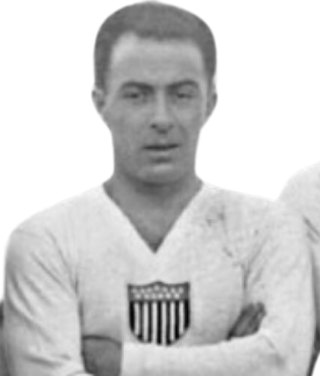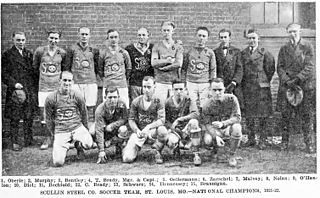Related Research Articles
Todd Shipyards F.C. was an American soccer club based in Brooklyn, New York that was an inaugural member of the American Soccer League. The team was formed when the Todd Shipyard company decided to merge the Brooklyn Robins Dry Dock with Tebo Yacht Basin F.C.
Robert Millar was a Scottish American soccer forward and coach of the U.S. national team at the first FIFA World Cup, in 1930. During his at times tumultuous Hall of Fame career, Millar played with over a dozen teams in at least five U.S. leagues as well as two seasons in the Scottish Football League. He finished his career as a successful professional and national team coach.

James J. Gallagher was a Scottish American soccer right wing midfielder who spent eleven seasons in the American Soccer League. He was a member of the U.S. soccer teams at the 1930 FIFA World Cup and 1934 FIFA World Cup. Gallagher was inducted into the National Soccer Hall of Fame in 1986.
The Brooklyn Robins Dry Dock were an American soccer team which took its name from the workplace it represented. The dock was part of the Todd Pacific Shipyards in Brooklyn who formed the professional soccer club in 1918 to play in the National Association Football League. Robins played until the league folded in 1921. Robins best finish was third in 1920 and 1921, but won the 1921 National Challenge Cup.
Neil G. Clarke(sometimes listed as Clark) was a Scottish American soccer player who began his career in the Scottish Football League before migrating to the United States. He played in both the National Association Football League and American Soccer League. In 1916, he played in the first two U.S. national team games.
Johnny "Jack" McGuire was a Scottish-U.S. soccer inside right who played professionally in both Scotland, Canada and the United States. He also earned one cap with the U.S. national team. He is a member of the National Soccer Hall of Fame.
Harry Jay Ratican was a U.S. soccer forward, coach and team owner. He began and ended his career in the St. Louis Soccer League with several years in both the National Association Football League and American Soccer League. He is a member of the National Soccer Hall of Fame.

St. Louis Scullin Steel was a U.S. soccer team established in St. Louis, Missouri in 1918. It spent seven seasons in the St. Louis Soccer League, winning three league titles and one National Challenge Cup.
Peter Renzulli was a U.S. soccer goalkeeper. He played in the New York State League, National Association Football League and the American Soccer League, winning three National Challenge Cups. Renzulli was inducted into the National Soccer Hall of Fame in 1951.
William J. "Tucker" Fryer was an English-American soccer half back. He is a member of the National Soccer Hall of Fame.
Tebo Yacht Basin was an amateur U.S. soccer team sponsored by the Tebo Yacht Basin company of Brooklyn, New York. It had a brief impact on the U.S. soccer scene from 1918 to 1921.

The 1920–21 National Challenge Cup was the annual open cup held by the United States Football Association now known as the Lamar Hunt U.S. Open Cup.
Robert Hosie was a Scottish soccer inside forward who began his career in Scotland before moving to the United States. In the U.S., he played one season in the National Association Football League and five in the American Soccer League.
Peter Sweeney was an early 20th-century Scottish-American soccer forward who began his professional career in Scotland before playing in the National Association Football League and American Soccer League in the United States.
Frank McKenna was a Scottish football wing forward who began his career in Scotland before playing eight seasons in the American Soccer League.
Frederick "Chiddy" Pepper was an English footballer who played as an inside forward. Born in Netherfield, Nottinghamshire, Pepper received a basic education before finding vocation as a fireman on the local railway. Joining Notts County F.C. in 1908 aged 21, he found little success playing in the English Football League and subsequently emigrated to Canada in 1913. Settling in Hamilton, Ontario, Pepper was scouted by industrialist Charles M. Schwab from local team Hamilton Lancashire and joined his Bethlehem Steel F.C. in 1914, an important club in the infancy of organized association football in the United States.
The 1922 American Cup tournament was not held. In accordance with new rules passed by the USFA, the American Football Association did not conduct a tournament for the 1921-22 season. The hiatus was brief, though, with the tournament resuming the following season.
Sullivan Drydock and Repair Corporation was a shipyard located in Brooklyn, New York. It was located off 23rd Street in Greenwood Heights/Sunset Park, in the Tebo Basin. Sullivan DD&RC built Submarine chasers, and altered, repaired and converted ships for various branches of the US military during World War II.
The 1921–22 Todd Shipyards F.C. season was the first season for Todd Shipyards F.C. and its first season in the American Soccer League. The Todd Shipyards Corporation had previously fielded the professional Robins Dry Dock F.C. and the amateur Tebo Yacht Basin F.C. The company combined the clubs to form Todd Shipyards F.C. and entered that club in the American Soccer League.
William Hogg Brownlie was a Scottish footballer who played as a left back.
References
- ↑ October 25, 1915 The Globe
- ↑ 1913-1914 Bethlehem Steel F.C. roster
- ↑ Jose, Colin (1998). American Soccer League, 1921-1931 (Hardback). The Scarecrow Press. ( ISBN 0-8108-3429-4).
- ↑ September 20, 1918 The Globe
- ↑ September 19, 1921 The Globe